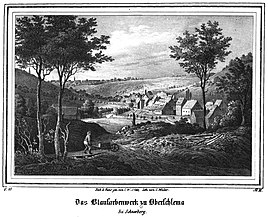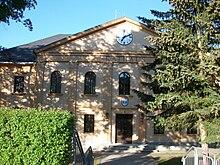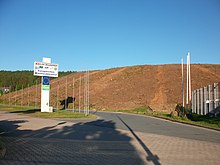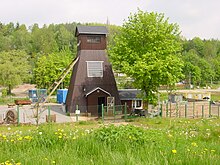Bad Schlema
|
Bad Schlema
City of Aue-Bad Schlema
|
|
|---|---|
| Coordinates: 50 ° 36 ′ 37 ″ N , 12 ° 40 ′ 58 ″ E | |
| Height : | 369 m |
| Area : | 15.51 km² |
| Residents : | 4777 (December 31, 2017) |
| Population density : | 308 inhabitants / km² |
| Incorporation : | 1st January 2019 |
| Postal code : | 08301 |
| Primaries : | 03772, 03771 |
|
Location of the Bad Schlema district in the Erzgebirge district
|
|
|
Blue color work for Oberschlema,
lithograph 1841 |
|
Bad Schlema has been one of four districts of the merged city of Aue-Bad Schlema since January 1, 2019 . It is located in the Erzgebirge in Saxony and is part of the Silberberg Association of Cities . Bad Schlema was an independent municipality until the end of 2018. The Silberstraße leads through the district . The tourism is for the place especially in the recreational - and the health sector is important. Bad Schlema is a state-approved health resort (therapeutic bath).
geography
Structure of the former municipality and the new city
Local areas of the spa are Oberschlema and Niederschlema. The other districts of Aue-Bad Schlema are Aue , Alberoda and Wildbach .
Geographical location
Ober- and Niederschlema are in the valley of the Schlemabach , which flows into the Zwickauer Mulde at the station in Niederschlema . Oberschlema extends from the local border to Schneeberg on the slope of Gleesberg to Hammerberg. Below the former Oberschlema train station, Niederschlema runs to the Zwickauer Mulde. Wildbach lies in the valley of the Wildbach, which also flows into the Zwickauer Mulde.
Neighboring communities
Neighboring communities are Schneeberg in the Erzgebirgskreis and Hartenstein and Langenweißbach in the district of Zwickau.
history
Today's Bad Schlema is made up of the formerly independent communities Niederschlema and Oberschlema . They were merged in 1958. The village of Wildbach , which was incorporated into Bad Schlema in 1994 , became an official separate district of the merged city of Aue-Bad Schlema on January 1, 2019 .
From the foundation to the 19th century
The two 800-year-old Schlematal communities became known for centuries of mining for iron, copper (especially at the “King David” mine on Gleesberg ), silver and uranium. In the immediate vicinity of the mountain town of Schneeberg , hammer mills and smelters for processing the ore were built in the Schlema valley. Around 1500 the construction of the more than 40 km long Marx-Semler-Adit began to drain the Schneeberger and Neustädtler pits . To procure the pit wood for the then almost treeless Schneeberger region, the 16 km long Schneeberg raft ditch was dug between 1556 and 1559 , the historic end of which was the Zechenplatz in Oberschlema. Johann Burkhardt founded the Oberschlema blue paint factory in 1644 , with 42 buildings later. In 1572 a paper mill was built in Oberschlema that produced very high quality handmade paper. Johann Sebastian Bach wrote parts of his works on Schlemaer paper.
From the 19th century: industrialization
In the period of industrialization, the Niederschlema factories by Toelle , Ehrler, Leonhardt, Rostosky and Philipp and the Oberschlema companies by Wilisch, Leonhardt, Kenzler and Müller were well known throughout Germany. Blue paint factories were built after the discovery of cobalt making blue paint . The largest blue ink factory in the world was created here. While the colored paper industry, embroidery and an enamelling factory predominated in Oberschlema, mechanical engineering, the paper and textile industries settled in Niederschlema. In 1858, Niederschlema was given a station on the Zwickau – Schwarzenberg line . A year later the Schlematalbahn branched off in the direction of Schneeberg-Neustädtel, which also gave Oberschlema a rail connection.
From the 20th century: health resort
When strong radon sources could be developed in the Oberschlemaer Marx-Semler-Stolln between 1908 and 1912 , the strongest radium bath in the world quickly developed after 1918 . The bath administration advertised bathing, drinking and inhalation cures ( emanation ) and sending radioactive water for drinking cures. Just ten years after it was founded, it was one of the most important German health resorts (over 17,000 spa guests in 1943). From October 31, 1924, the Oberschlema community was allowed to use the title “Radiumbad Oberschlema” with the consent of the Interior Ministry.
From the beginning of uranium mining in 1946 to the political turning point in 1990
With the start of uranium ore mining in 1946 by the object 02 of the later Wismut AG , the Radiumbad Oberschlema spa became its early mining center in the Western Ore Mountains . As a result of the near-surface mining of the coveted uranium, the lowering of the Oberschlema valley area began in 1949. From May 1952, the demolition of the entire town center with the church, community and spa center began. The railway line was shut down on August 1, 1952. All the radon sources that had been tapped were now destroyed and dried up.
On July 16, 1955, a serious accident occurred underground that left 33 dead and over 100 injured. Many rescue workers were among the victims.
Due to the uranium ore mining, the urban district of Schneeberg was founded on December 17, 1951 and the Radiumbad Oberschlema and Niederschlema became districts. With the dissolution of the urban district on November 23, 1958, both places became independent again as the municipality of Schlema and from then on belonged to the district of Aue . By 1990, the SDAG Wismut had mined almost 80,000 t of pure uranium from the Schlema, Silberbach and neighboring Mulde valleys .
In 1950, the construction of the women's clinic at the Aue Clinic began in Oberschlema . Commissioning took place three years later. In 1972 the branch was expanded to include the ENT and Eye Clinic.
From the German reunification in 1990: revitalization of the health resort
After the end of mining in 1991, the former mayor of Schlema, Konrad Barth, organized the revitalization as a health resort, which became a reality in 1998 with the opening of the new health resort. The newly developed radon springs on the Gleesberg enable a generous swimming pool, which up to 1,000 guests use the Actinon health pool every day .
In 1994 the municipality of Wildbach was incorporated, and at the end of 2018 it was removed again .
On January 18, 2005, the Saxon state government awarded the Schlema spa town the rating bath , after it had been a recognized radon spa since October 29, 2004 . The place is the first to be awarded this designation after 1990.
The heaps created by the intensive uranium ore mining on the edge of the place could be gradually rehabilitated, above all covered and replanted. Halde 65 is known beyond Bad Schlema . Its renovation took several years (beginning in 2018) and will end on July 2, 2020 with a symbolic last truck trip on site.
Population development
The following population figures refer to December 31st of the respective year with the territorial status January 2007:
|
1982 to 1988
|
1989 to 1995
|
1996 to 2002
|
2003 to 2009
|
2012 to 2017
|
- Source: State Statistical Office of the Free State of Saxony
Schlema Women's Clinic
Between 1953 and 2000, 57,479 children were born in the Schlema Women's Clinic. In 2000, the women's, eye and ENT clinic moved to the new building of the Helios Clinic on the Zeller Berg in Aue. The buildings in Schlema were demolished in 2009.
Religions
Each of the three former Bad Schlema districts has its own Evangelical Lutheran church, which is part of the Bad Schlema parish :
The parish church in the Wildbach district was built between 1804 and 1806 and for a long time was the main church of the former Schönburg villages of Wildbach and Langenbach.
The Martin Luther Church in Niederschlema was built from 1898 to 1899 and formed a parish with the parishes of Oberschlema and Klösterlein cell (today a part of Aue) until the 20th century.
The old church of Oberschlema was built in 1573 and was the main church of the Parish for centuries. It had to be closed due to subsidence in the early 1950s and was demolished in the period that followed. Oberschlema then received the Church of the Resurrection, the only church in the GDR that was completely state-funded. During the construction period of the Resurrection Church, the community received a wooden church barrack of the type “House of the Church” from Otto Bartning's emergency church program (so-called “ Bartning-Notkirche ”, type D). After the Church of the Resurrection was completed in 1952, this barrack was moved to the mining settlement of Schneeberg- Wolfgangmaßen and has served as a church for the community in Auerhammer and Neudörfel since 1959 .
The regional church community Bad Schlema has its community center in Niederschlema. In Wildbach the regional church community meets in the rectory of the parish Wildbach.
politics
Municipal council
Since the municipal council election on May 25, 2014 , the 18 seats of the municipal council have been distributed among the individual groups as follows:
Merger with a neighboring city
Mayor Jens Müller and the city council operated the voluntary merger between Bad Schlemas and Aue on January 1, 2019. The mayor and city councilors of Aue also approved this project. In addition to Bad Schlema's financial problems, one reason for the merger is the development of the population. Since 1990 the number in Schlema has decreased by 1,725 to 4,800. Aue's number of residents fell from 30,000 to just 16,200. The contract negotiated between the administrations of both cities was publicly available to interested residents. At information events, citizens of Schlemas also represented the option of uniting with Schneeberg instead of Aue. One of the fears was that Schlema's interests could not be adequately represented in the larger unit. Due to the higher number of inhabitants, the merged city of Aue-Bad Schlema would receive around one million euros more in key allocations from the State of Saxony under the Financial Equalization Act. Despite all concerns, the merger with Aue was officially completed.
Local partnership
Bad Schlema has a partnership with Rechberghausen in Baden-Württemberg.
Economy and Infrastructure
deals
According to the historical development of the place, there are numerous spa, bathing and beauty facilities. Tourism is an important economic factor. Smaller construction companies and service providers also play a role.
traffic
Federal road 169 runs through the Oberschlema district .
With the Bad Schlema train station (formerly: Schlema unt Bf), the place has a connection to the Zwickau – Schwarzenberg railway line (Erzgeb.) . From 1859 to 1952 the Schlematalbahn ran through the town to Schneeberg-Neustädtel. Due to the lowering of the track bed by one meter caused by mining, passenger traffic was discontinued from April 7, 1952, and freight traffic between Oberschlema and Schneeberg also ceased on August 1, 1952. After the end of passenger traffic between Niederschlema and Oberschlema, the route was only important for goods traffic from 1960 onwards. This ended in 1993; the complete shutdown followed on June 6, 1996. In 1998 all tracks were removed and in the following years a railway nature trail was created.
Educational institutions
In the area of Niederschlema there is a state primary school and a private high school. Oberschlema had its own elementary school until the 1990s. The state education center of the Saxon roofing trade e. V. is also located in Bad Schlema.
Culture and sights
Memorials
- With a memorial at Kohlweg in the local area Niederschlema is at 83 prisoners KZ reminded that with a death march of the outer bearing Mülsen -St. Micheln of the Flossenbürg concentration camp were murdered by SS men in April 1945 . At the same time, the memorial, which was redesigned by Kurt Teubner in 1973, commemorates the 18 Soviet citizens who also lost their lives here.
- The Biedenkopfstein on the Hammerberg honors the commitment of the couple Ingrid and Kurt Biedenkopf to the rebirth of a Schlema spa.
- A memorial stone in the cemetery in the Wildbach district commemorates the Wildbach men who fell in the world wars. The memorial for those who died in Niederschlema was destroyed in 1945 and those who died in Oberschlema in 1953 and never rebuilt.
- In Richard-Friedrich-Park near the Kurhaus a stone reminds of the spiritual father of the old Radiumbad Oberschlema, the master builder Richard Franz Friedrich . Two attached panels honor the commitment of deserving people to the renaissance of the bathroom after 1990.
- In the honor grove on the site of the former shaft 250 there is half a conveyor disk with a memorial plaque to commemorate the miners who died in the worst uranium mining accident (33 dead) in the GDR in July 1955.
Museums
- Bad Schlema visitor mine
- Uranium Mining Museum - traditional site of Saxon-Thuringian uranium ore mining
- Schlema e. V. (Lindenweg 3)
music
- Silberbach Choir
- Bergmannsblasorchester Kurbad Schlema e. V.
- Music fountain at the spa park
Parks
- Kurpark, u. a. with a planetary hiking trail, awning, fallow deer enclosure, raft ditch
- Richard-Friedrich-Park with boulder and grotto
Regular events
In 1996 the Bergmannsblasorchester Bad Schlema organized the International Wind Music Festival in the village for the first time . The festival, which has taken place every September since then, is played by several orchestras alternately on two stages. Several thousand visitors regularly enjoy the event.
The bakery shown in the picture is a historic pump house , which was converted into a bakery on the initiative of the Backhaus Schlema eV association and equipped with a clay oven designed according to old templates . The non-profit association founded in 2003 , which initially consisted of 13 members and now has 34 members, operates the bakery. Public baking events take place here on a regular basis, for example the Easter baking and the baking house festival . A guest room is also available for private purposes.
Since 1998 the spring and wine festival has been held on the weekend after October 3rd . Every two years (even year) the election of the representative of the health resort - the Bad Schlemaer Brunnenmaiden - is the highlight of the festival. This young woman has the voluntary task of representing the health resort at various events, e.g. B. at trade fairs and festivals all over Germany and beyond.
Since January 1, 1999, the Chamber Philharmonic Miriquidi ( Miriquidi stands for the medieval name of the Ore Mountains) has been organizing a New Year's concert every year in the Kulturhaus Aktivist. With the participation of opera singers and, since 2004, also with the Silberbach Choir Bad Schlema, operetta melodies and excerpts from operas are performed.
Personalities
Sons and daughters of Bad Schlema
- Richard Franz Friedrich (1848–1916), master builder and radiologist, co-founder of the Oberschlema radium bath
- Lothar Wendler (1927–2016), local politician and local researcher, born in Wildbach
- Siegfried Klotz (1939–2004), painter
- Hans-Jürgen Beier (* 1956), prehistorian and publisher
- Wolfgang Schmiedt (* 1959), musician
- Sören Schlegel (* 1960), athlete (sprinter)
- Karsten Speck (* 1960), entertainer and actor
- Erwin Stache (* 1960), sound artist, composer, musician and object builder
- Tom Breck (* 1961), power juggler
- Sebastian Günther (* 1961), Islamic scholar
- Michael Klonovsky (* 1962), journalist, writer
- Steffi Martin (1962–2017), luge athlete
- Rico Gebhardt (* 1963), politician (Die Linke)
- Dyrck Schneidbach (* 1964), engineer and politician (CDU)
- Mike Fuhrig (* 1965), handball player
- Steffen Krauss (1965–2008), football player
- Ulf Leonhardt (* 1965), physicist
- Henning Schmiedt (* 1965), musician
- Birk Anders (* 1967), biathlete
- Michael Harbauer (* 1969), director of the SCHLINGEL international film festival for children and young audiences
- Tino Licht (* 1969), philologist
- Ricco Groß (* 1970), biathlete
- Saskia Fischer (* 1971), writer
- Jörg Felgner (* 1972), politician (SPD)
- Ronny Rockel (* 1972), bodybuilder
- Erik Göthel (* 1973), handball player
- Michael Leutert (* 1974), politician (Die Linke)
- Diana Näcke (* 1974), director
- Ally Storch (* 1976), musician
- Johannes Unger (* 1976), organist
- Enrico Kern (* 1979), soccer player
- Denise Herrmann (* 1988), biathlete and cross-country skier
- Robert Jendrusch (* 1996), football player
Persons connected to Bad Schlema
On July 4, 2010, in the lecture German contributions to manned space flight in the Cultural Center activists in Bad Schlema, as part of the Festival 10 years Mountain brotherhood Bad Schlema , Sigmund Jähn in his presence the honorary membership of the mountain brotherhood Bad Schlema eV awarded.
literature
- Martin Ebert, Wolfram Keßler: Schlemas Waters worked wonders - Radiumbad Oberschlema , publisher Schlema municipal administration, approx. 1991.
- Project group UNESCO World Heritage Ore Mountains Mining Region: wfe.eu pilot study Bad Schlema - Establishing and defining the World Heritage areas and buffer zones as part of the Ore Mountains Mining Region project (PDF; 7.1 MB), Freiberg 2012.
- Oliver Titzmann: Uranium mining versus radium bath. The effects of uranium mining by SAG Wismut on the Radiumbad Oberschlema community. O. Titzmann, Schlema 2003 (dissertation, University of Leipzig 2002).
- Oliver Titzmann: Radium bath Oberschlema. The history of a health resort . Self-published, 1995.
Web links
- Website of the community
- Literature about Bad Schlema in the Saxon Bibliography
- Bad Schlema in the Digital Historical Directory of Saxony
- Precipitation in the digital historical place directory of Saxony
- Oberschlema in the digital historical place directory of Saxony
- Presentation of the situation in Bad Schlema after the end of uranium mining ( memento from January 5, 2013 in the web archive archive.today )
- History of settlement and mining in Schlema
Individual evidence
- ↑ Announcement of the Saxon State Ministry for Economics, Labor and Transport on the change of the list of health and recreation places in the Free State of Saxony according to § 3 Abs. 5 SächsKurG from January 20, 2014.
- ↑ a b c Press release from Aue Town Hall: Merger of Bad Schlema with the large district town of Aue , December 20, 2018.
- ↑ Saxon State Chancellery Law and Ordinance Gazette
- ↑ Press release from the town hall of Aue-Bad Schlema from June 30th, 2020: Milestone reached in the renovation of the heap 65 in Aue-Bad Schlema .
- ↑ List of churches by Otto Bartning
- ↑ Results of the 2014 municipal council elections
- ↑ Not all desired marriages are welcome . In: Freie Presse , April 4, 2018, p. 2.
- ↑ Community mergers are making slow progress despite the lack of money. In: Freie Presse , April 4, 2018, p. 1
- ↑ Bad Schlema company directory , accessed on May 2, 2020.
- ^ Homepage of the Uranium Mining Museum
- ↑ Homepage with the presentation of mining traditions (PDF; 3.5 MB) p. 12
- ^ Website from Backhaus Schlema eV , accessed on February 27, 2019.
- ↑ Well girl in double duty . In: Daily newspaper Freie Presse , October 6, 2008.
- ^ Lecture by S. Jähn in Bad Schalema on the Bergbrüderschaft website, accessed on May 13, 2019.

















